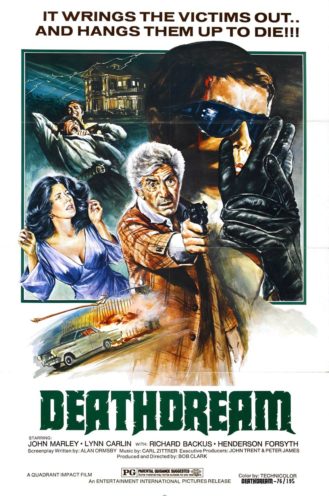 A young soldier returns home from Vietnam as a zombie with an insatiable addiction to blood in DEATHDREAM, a bonafide seventies cult classic. One of the earliest films of any sort to deal seriously with the then raging Vietnam War, it’s both an effective horror thriller and a troubling look at the plight of war veterans readjusting to civilian life.
A young soldier returns home from Vietnam as a zombie with an insatiable addiction to blood in DEATHDREAM, a bonafide seventies cult classic. One of the earliest films of any sort to deal seriously with the then raging Vietnam War, it’s both an effective horror thriller and a troubling look at the plight of war veterans readjusting to civilian life.
The source material for DEATHDREAM (1974) was W.W. Jacobs’ classic story “The Monkey’s Paw”, in which an elderly couple use a magic monkey’s paw to wish for a large sum of money, which unfortunately comes at the expense of their grown son’s life; even more damaging are their subsequent attempts at setting things right, which only intensify the horror. The story’s underlying themes fit surprisingly well into an early seventies Vietnam War framework, and the political subtext was strictly intentional on the part of the filmmakers. To quote the script’s final line (cut from the film): “Andy came back. Some boys never do.”
The makers of DEATHDREAM were director Bob Clark and screenwriter Alan Ormsby, who previously collaborated on 1972’s CHILDREN SHOULDN’T PLAY WITH DEAD THINGS and went on to make 1974’s DERANGED (which Clark produced, but had his name removed from the credits) together. From there Ormsby wrote the scripts for CAT PEOPLE (1982), POPCORN (1991) and THE SUBSTITUTE (1996) while Clark went on to one of the most eccentric directorial careers imaginable. His flair for horror was amply demonstrated by DEATHDREAM, BLACK CHRISTMAS (1974) and MURDER BY DECREE (1979), but his subsequent films included the gross-out classic PORKY’S (1981), the nostalgic Yuletide favorite A CHRISTMAS STORY (1983), the notorious Sly Stallone flop RHINESTONE (1984) and the forgettable kid flick BABY GENIUSES (1999).
Another interesting fact about DEATHDREAM is that it’s probably had more title changes than nearly any other movie. THE VETERAN was its working title, which later became (in no particular order) DEAD OF NIGHT, WHISPERS, THE NIGHT WALK and THE NIGHT ANDY CAME HOME. The present moniker wasn’t arrived upon until after the film’s initial release. Ormsby claims he isn’t satisfied with DEATHDREAM as a title (because “it’s not a dream”), but does acknowledge that it’s the best of the bunch.
In the jungles of Vietnam , an unidentified young man is shot and killed in a firefight. Back in a comfortable suburban neighborhood, a family is devastated to learn their son Andy (presumably the guy we saw in the prologue) has been killed in action. Shortly thereafter, however, Andy shows up on their doorstep one night looking none the worse for wear.
But things aren’t nearly as idyllic as they might seem. Andy has become sullen and withdrawn to the point of near-catatonia, and the eviscerated body of a trucker has been found in the area—the very trucker, it turns out, who gave Andy his ride home.
Andy’s behavior grows freakier by the day: he strangles the family dog, twists the arm of a neighborhood kid and stabs to death the family doctor after coyly revealing to the latter his secret. Andy, it seems, is a vampire who needs a constant supply of human blood to keep from becoming a rotting corpse. His next victim is an old girlfriend who makes the mistake of accompanying Andy on a double date. Her death isn’t enough, however, to keep his flesh from decaying at an alarming rate until he’s nearly done for, and all he can do is crawl into an open grave…his own!
While DEATHDREAM is miles ahead of Bob Clark’s first film, the highly amateurish CHILDREN SHOULDN’T PLAY WITH DEAD THINGS, it’s still extremely ragged around the edges. The camerawork tends to be unsteady and often downright clumsy, while the camera placement rarely ever feels correct. And let’s not even get started on the oft-tacky lighting perpetrated by cinematographer Jack McGowan—it’s been said that double and/or triple shadows on walls are a “sin” in the cinematography world, in which case DEATHDREAM is guaranteed an eternity in Hell! The screenplay also has quite a few problems, in particular the way it blatantly telegraphs any and all plot developments, a tendency most notable in its insistence on revealing in the opening scene that the main character is dead rather than letting audiences figure that fact out for themselves (the movie’s distributors even went so far as to require that theater owners not let anyone in after the first five minutes).
Offsetting all this is Clark ’s expertise in conjuring a deeply ominous atmosphere of darkness and foreboding that compels even when the budget-lite visuals falter. The lead performances by John Marley, Lynn Carlin (both John Cassavettes veterans) and the debuting Richard Backus, who creates a singularly creepy vampire, are all likewise extremely effective. And the primitive but inspired gore FX by a young Tom Savini are above average. The end result is a singularly haunting experience made all the more memorable for its inescapable real-life parallels.
Vital Statistics
DEATHDREAM
Entertainment International Pictures
Director: Bob Clark
Producer: Bob Clark
Screenplay: Alan Ormsby
Cinematography: Jack McGowan
Editing: Ronald Sinclair
Cast: John Marley, Lynn Carlin, Richard Backus, Henderson Forsythe, Anya Ormsby, Jane Daly, Michael Mazes, Arthur Anderson, Arthur Bradley, David Gawlikowski, Virginia Cortez, Bud Hoey, Robert R. Canon, Raymond Michel, Jeff Becker, Scott Becker, Greg Wells, Kevin Schweizer
